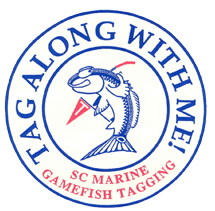Marine - Species
Tarpon (Megalops atlanticus)
General Description
Silvery, scales large, eyes large; lower jaw projects forward of fish. Dorsal fin originates near mid-point of body; last ray on dorsal fin filamentous and very long.
Average Size
40 – 60 inches, 40 – 60 pounds;
South Carolina State Record: 154 pounds 10 ounces (1987);
maximum age: approx. 50 years – possibly up to 70 years.
Habitat
Juveniles and adults inhabit temperate and tropical waters and are capable of tolerating wide salinity ranges. Larger fish are primarily marine but may enter brackish estuaries and fresh water rivers.
Adults: Typically inhabit nearshore waters including bays, sounds, or estuaries; also enter rivers.
Juveniles: Prefer salt marsh and estuarine habitats; may move into fresh water impoundments and upper reaches of coastal rivers; older juveniles move to deeper canals, bays, and coastal waters.
Reproductive Cycle
- Both sexes mature by approximately 10 years of age; approx. size at maturity: males – 35 inches, females – 49 inches.
- Spawning most likely occurs offshore after migration from inshore aggregation areas. In South Carolina, spawning occurs May – August.
- Larvae proceed through a leptocephalus larva stage lasting 2 – 3 months. These transparent, leaf-like larvae require high-salinity, oceanic water and metamorphose offshore prior to moving to inshore nursery habitats.
Foraging Habits
- Adults and older juveniles are mostly piscivorous (fish-eating) and consume mid-water prey. Prey species include: striped mullet, silversides, salt water catfishes, pinfish, menhaden, and ribbonfish. May also consume blue crab and penaeid shrimp.
- Young juveniles consume small fishes, crabs, grass shrimp, and zooplankton; may also capture insects.
Availability/Vulnerability to Harvest
- In South Carolina from April to peak in July/August. Distribution is temperature regulated. Tarpon inhabit temperate to tropical waters and may be cold stunned and die in water less than 50degF. Probably overwinter in Florida waters, migrating north in spring, south in fall.
- Tarpon may form schools of a few to more than a hundred fish, especially in preparation for spawning.
- Adults and older juveniles tolerate low-quality habitats such as shallow, muddy, and anoxic water due to their ability to breathe air through a modified swimbladder.
- Conservation concerns: Degradation of estuarine nursery grounds; inshore and nearshore water quality; location of spawning areas unknown; lack of biological data for this species in South Carolina waters.
Literature Cited
Ault JS. 2008. Biology and management of the world tarpon and bonefish fisheries. CRC Press, Boca Raton, FL. 441 pp.
Fischer W. 1978. FAO identification sheets for fisheries purposes: western central Atlantic (fishing area 31) volume 1 – 7. Food and Agriculture Organization of the United Nations, Rome.
Hammond DL. 2005. Tarpon. In: Comprehensive Wildlife Conservation Strategy. South Carolina Department of Natural Resources, Columbia, SC. Available: https://www.dnr.sc.gov/cwcs/pdf/Tarpon.pdf. Accessed: August, 2009.
Moore CJ. 1996. A field guide to the identification of marine species regulated in South Carolina coastal waters. Office of Fisheries Management, Marine Resources Division, South Carolina Wildlife and Marine Resources Department, Charleston, SC. 105 pp.
Moore CJ, M Barkley. 2005. South Carolina's guide to saltwater fishes. South Carolina Department of Natural Resources, Special Publication. Columbia, SC. 132 pp.
Zale AV, and SG Merrifield. 1989. Species profiles: life histories and environmental requirements of coastal fishes and invertebrates (South Florida) – tarpon. U.S. Fish Wildl. Serv. Biol. Rep. 82(11.104). U.S. Army Corps of Engineers, TR EL-82-4. 17pp. Accessed: September, 2009.


